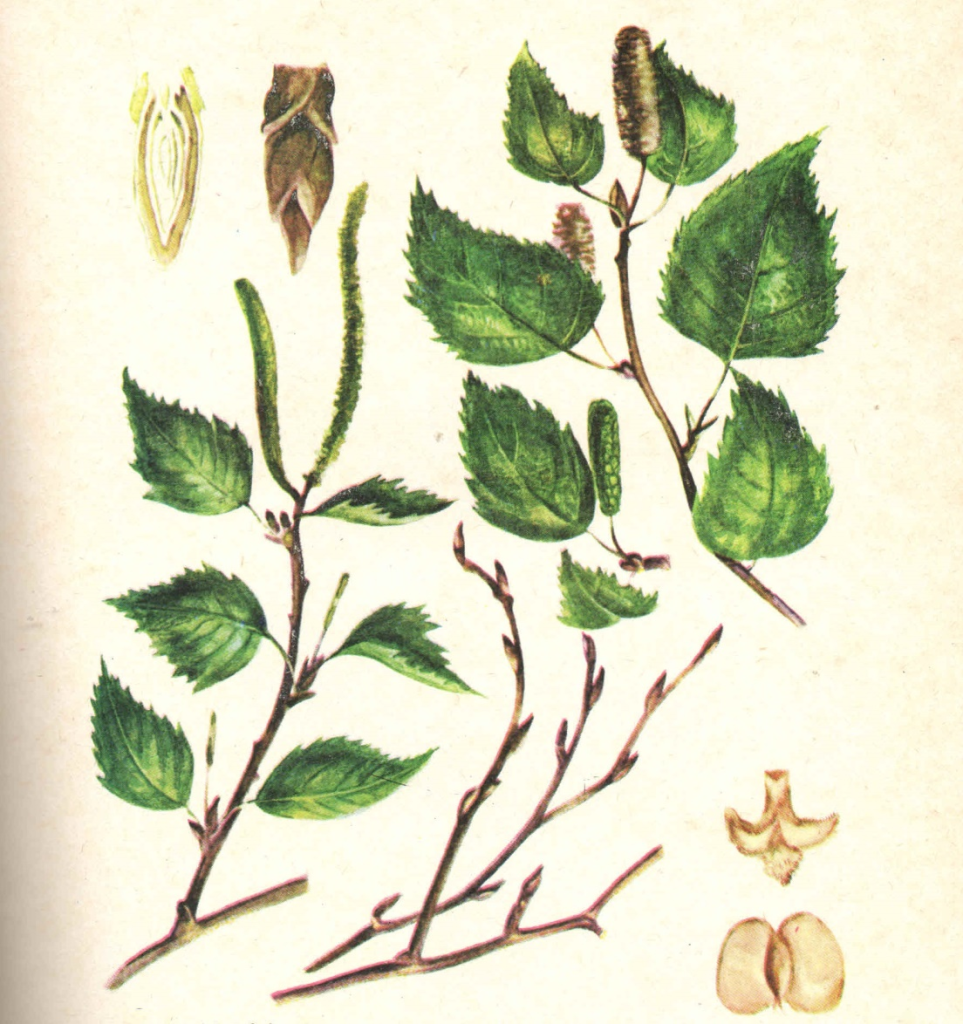FAMILY-BETULACEAE
Monoecious trees and shrubs with separate-sexed inflorescences, with simple alternate petiolate leaves. The flowers have a simple reduced perianth or are without one, the ovary is inferior and bi-chambered. The plants are wind-pollinated. They bloom in early spring before or at the start of leaf opening. The staminate flowers are gathered in long catkins in the axils of scales, which are easily swayed by the wind, dispersing pollen, and are located on pedicels at the tips of the branches. The pistillate flowers, covered with scales, are collected in short spikes.
Tannins are present in significant or lesser amounts in the bark, leaves, and sometimes in the fruits (Alnus); flavones are found in the leaves; almost all species contain derivatives of quercetin, and often of kaempferol and myricetin. Calcium oxalate is often present in the form of druses and solitary crystals. Sometimes there are a small amount of saponins; essential oils are found in the epidermal glands on the leaves and buds of some genera. In the seeds, there is fat oil; nuts, rich in fat oil and aleurone, are found in the genus Corylus.
The medicinal importance is primarily in the genera Betula and Alnus. The bracts of the hazelnut tree (Corylus avellana) are studied and used in medicine as an astringent.
The buds and leaves of birch species from the Alba section — trees with white bark, which owes its color to betulin (25%), a resin-like substance — are collected. Dark parts of the bark contain tannins. These plants grow throughout the forest zone. Most commonly used is Betula pendula Roth. (Betula verrucosa Ehrh.), whose branches are warty, and the leaves are rhombic or heart-shaped, with double-serrate edges, glabrous.

Birch leaf buds — Gemmae Betulae, which are set in autumn, are harvested early in spring during sap flow, as they begin to swell but before they open and the scales separate; earlier collection (starting from February) is also acceptable. Branches are cut in forest clearings to collect catkins, and simultaneously, buds are taken from them. The branches with buds are dried for a long period in cold conditions, as the buds will open in warmth. After drying, the buds are stripped or twisted off the branches and cleaned from the catkins. Birch leaves — Folium Betulae — are collected in May during flowering, when they are covered with essential oil glands, aromatic and sticky.
Birch buds yield 3.5-8% essential oil when distilled with steam. This is a thick yellow liquid with a pleasant balsamic smell. The oil contains the bicyclic sesquiterpene alcohol betulol (40-47% free and 30-45% bound as an ester with acetic acid) and other substances.
From the leaves of birch, 0.05% brown essential oil is obtained, containing sesquiterpenes. Additionally, both buds and leaves contain vitamin C, saponins, flavonoids, and resin. The buds and leaves also contain antibiotic substances with strong bactericidal properties.
The buds are used in the form of infusions as a diuretic and choleretic for treating cholecystitis.
The buds are brewed like tea. Take 1 teaspoon of buds per ½ cup of boiling water, and consume in 3 doses throughout the day.
For external use in cases of bedsores, a 90% alcohol tincture of buds is used at a ratio of 1:5. Additionally, birch sap, rich in vitamins, is consumed in the spring.
Birch tar — Pix liquida Betulae — is obtained by dry distillation of wood. The tar is a thick dark brown liquid, translucent in thin layers, with a characteristic odor, and contains phenols and resins. Birch tar has strong disinfectant properties and is used as an external remedy, especially in ointments for scabies (Wilkinson’s ointment), and for treating wounds (it is an ingredient in Vishnevsky’s ointment).
Charcoal — Carbo — has a porous structure, and it easily absorbs liquids, gases, and pigments. Its absorbent capacity is enhanced by treatment with steam at high temperatures. The resulting product is called activated charcoal — Carbo activatus. In medicine, charcoal is used in powder or tablet form, under the name Carbolen, to treat excessive gas formation in the gastrointestinal tract.
